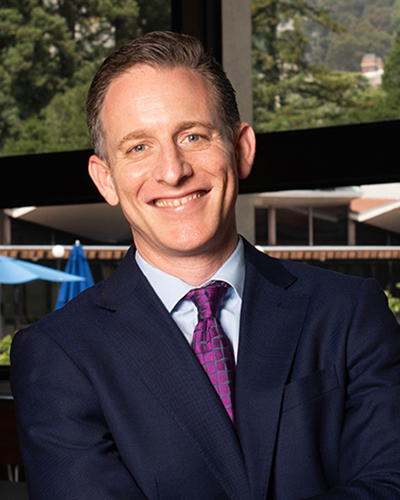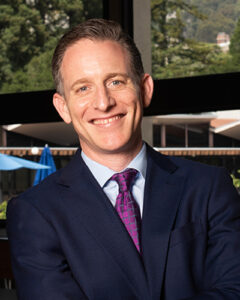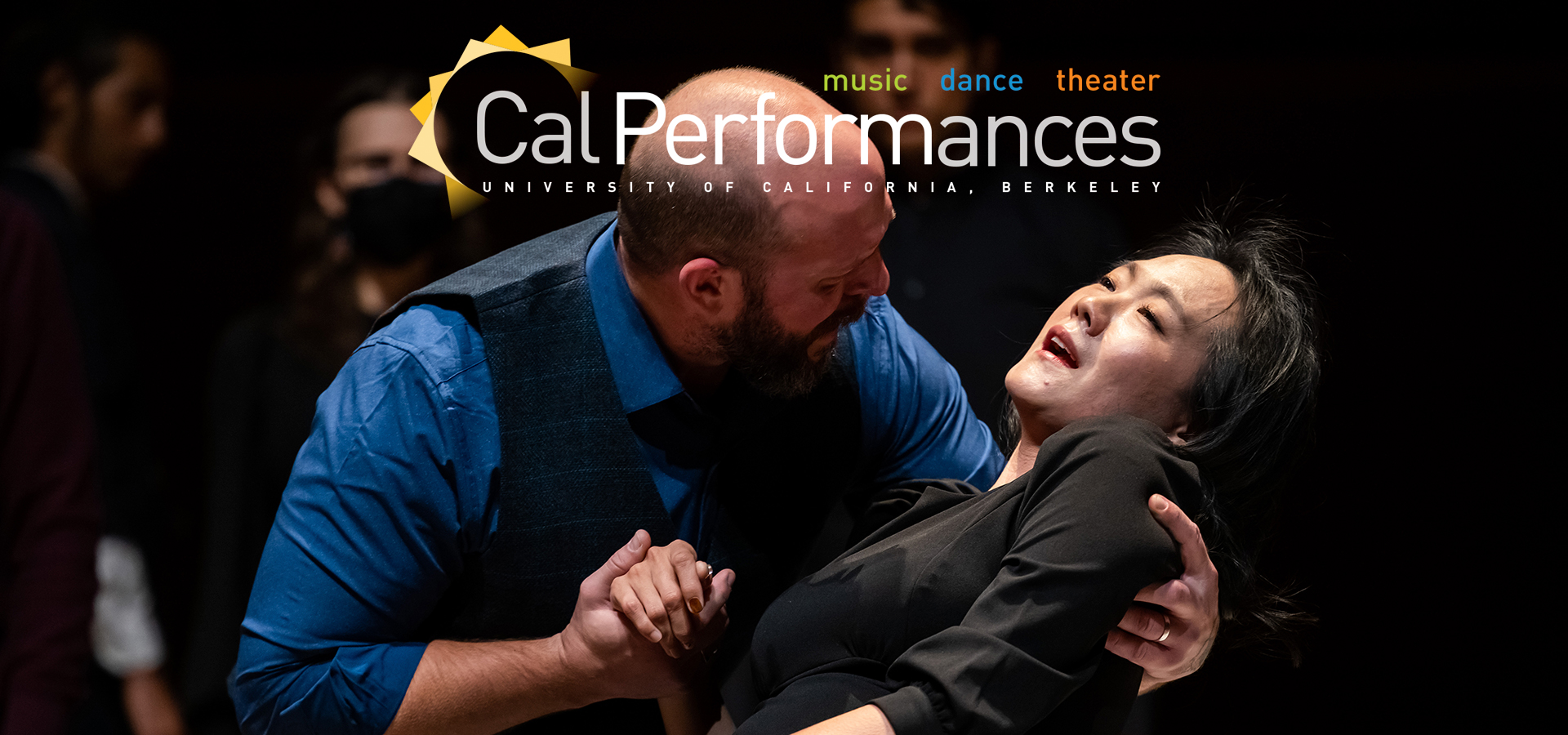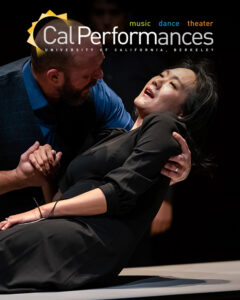Music to Accompany a Departure
Saturday, October 28, 2023, 8pm
Zellerbach Hall
Tonight’s program will be performed without intermission and last approximately 80 minutes.
Music to Accompany a Departure is made possible by generous support from Lillian Pierson Lovelace, Patrick R. Fitzgerald, and Ron Myrick.
The touring production is supported by the Joan and Jeff Beal Artistic Innovation Fund, the Andrea and Gregory Williams Collaborating Artists Fund, and Mid Atlantic Arts Foundation.
This performance is made possible, in part, by Nadine Tang.
From the Executive and Artistic Director

Welcome to the opening weeks of Cal Performances’ brilliant 2023–24 season! Beginning on October 1 with the Berkeley debut by the brilliant young Israeli pianist Tom Borrow, and continuing into May, when Icelandic pianist Víkingur Ólafsson will close the season with a performance of J.S. Bach’s timeless Goldberg Variations, you can look forward to a calendar packed with the very finest in live music, dance, and theater.
We start with a powerhouse lineup of remarkable musicians. Along with Tom Borrow, October features highly anticipated performances by artists like soprano Christine Goerke and pianist Craig Terry, mandolinist Avi Avital and accordionist Hanzhi Wang, the Los Angeles Master Chorale, and pianist Michelle Cann. We’ll also enjoy an exciting combination of hot jazz music and dazzling animation in the Triplets of Belleville Cine-Concert. And we’ll round out the schedule with presentations by two exciting guest speakers, the renowned artist and human rights activist Ai Weiwei (appearing with guests Peter Sellars and Orville Schell) and popular New York Times columnist and podcast host Ezra Klein.
As we continue through the season, you’ll find more than 80 carefully curated events designed to appeal to the eclectic interests and adventurous sensibilities of Bay Area audiences. This year’s schedule features nearly 30 companies, ensembles, and solo artists new to our program, offering a wide range of opportunities to discover unfamiliar performers and artworks. There’s plenty to enjoy, including six world premieres, six Cal Performances co-commissions, nearly one dozen local and regional premieres, and the West Coast premieres of Taylor Mac & Matt Ray’s Bark of Millions and Nathalie Joachim’s Ki moun ou ye (Who are you?).
Cal Performances continues to invest in ongoing relationships with established and acclaimed artistic partners, with upcoming presentations including a landmark collaboration between Germany’s Pina Bausch Foundation, Senegal’s École des Sables, and the UK’s Sadler’s Wells theater in the first-ever Bay Area performances of Bausch’s pioneering The Rite of Spring (1975), as well as the renewal of a multi-season residency by The Joffrey Ballet, which this year will present its first full-length narrative ballet, Anna Karenina, at Zellerbach Hall. And I’m especially pleased that in March 2024, the renowned pianist Mitsuko Uchida will join us as Artist in Residence for two special concerts as well as additional opportunities for the campus and wider Bay Area community to engage with her singular artistry.
A focus of the season will be our multi-dimensional Illuminations programming, which once again will connect the work of world-class artists to the intellectual life and scholarship at UC Berkeley via performances and public programs investigating a pressing theme—this season, “Individual & Community.” Concepts of “individual” and “community” have been at the forefront of public discourse in recent years, with some models increasing polarization and radicalization within our society. Questions have emerged as to how we can best nurture a sense of community and how the groups we associate with impact our own sense of self. Given our fast-evolving social landscape, how can we retain and celebrate the traits that make each of us unique, while still thriving in a world that demands cooperation and collaboration? With the performing arts serving as our guide and compass, our 2023–24 “Individual & Community” programming will explore the tensions that come into play when balancing the interests of the individual with those of the group.
Please make sure to check out our latest brochure and our website for complete information. We’re thrilled to share all the details with you, in print and online!
Jeremy Geffen
Executive and Artistic Director, Cal Performances
 Welcome to the opening weeks of Cal Performances’ brilliant 2023–24 season! Beginning on October 1 with the Berkeley debut by the brilliant young Israeli pianist Tom Borrow, and continuing into May, when Icelandic pianist Víkingur Ólafsson will close the season with a performance of J.S. Bach’s timeless Goldberg Variations, you can look forward to a calendar packed with the very finest in live music, dance, and theater.
Welcome to the opening weeks of Cal Performances’ brilliant 2023–24 season! Beginning on October 1 with the Berkeley debut by the brilliant young Israeli pianist Tom Borrow, and continuing into May, when Icelandic pianist Víkingur Ólafsson will close the season with a performance of J.S. Bach’s timeless Goldberg Variations, you can look forward to a calendar packed with the very finest in live music, dance, and theater.
We start with a powerhouse lineup of remarkable musicians. Along with Tom Borrow, October features highly anticipated performances by artists like soprano Christine Goerke and pianist Craig Terry, mandolinist Avi Avital and accordionist Hanzhi Wang, the Los Angeles Master Chorale, and pianist Michelle Cann. We’ll also enjoy an exciting combination of hot jazz music and dazzling animation in the Triplets of Belleville Cine-Concert. And we’ll round out the schedule with presentations by two exciting guest speakers, the renowned artist and human rights activist Ai Weiwei (appearing with guests Peter Sellars and Orville Schell) and popular New York Times columnist and podcast host Ezra Klein.
As we continue through the season, you’ll find more than 80 carefully curated events designed to appeal to the eclectic interests and adventurous sensibilities of Bay Area audiences. This year’s schedule features nearly 30 companies, ensembles, and solo artists new to our program, offering a wide range of opportunities to discover unfamiliar performers and artworks. There’s plenty to enjoy, including six world premieres, six Cal Performances co-commissions, nearly one dozen local and regional premieres, and the West Coast premieres of Taylor Mac & Matt Ray’s Bark of Millions and Nathalie Joachim’s Ki moun ou ye (Who are you?).
Cal Performances continues to invest in ongoing relationships with established and acclaimed artistic partners, with upcoming presentations including a landmark collaboration between Germany’s Pina Bausch Foundation, Senegal’s École des Sables, and the UK’s Sadler’s Wells theater in the first-ever Bay Area performances of Bausch’s pioneering The Rite of Spring (1975), as well as the renewal of a multi-season residency by The Joffrey Ballet, which this year will present its first full-length narrative ballet, Anna Karenina, at Zellerbach Hall. And I’m especially pleased that in March 2024, the renowned pianist Mitsuko Uchida will join us as Artist in Residence for two special concerts as well as additional opportunities for the campus and wider Bay Area community to engage with her singular artistry.
A focus of the season will be our multi-dimensional Illuminations programming, which once again will connect the work of world-class artists to the intellectual life and scholarship at UC Berkeley via performances and public programs investigating a pressing theme—this season, “Individual & Community.” Concepts of “individual” and “community” have been at the forefront of public discourse in recent years, with some models increasing polarization and radicalization within our society. Questions have emerged as to how we can best nurture a sense of community and how the groups we associate with impact our own sense of self. Given our fast-evolving social landscape, how can we retain and celebrate the traits that make each of us unique, while still thriving in a world that demands cooperation and collaboration? With the performing arts serving as our guide and compass, our 2023–24 “Individual & Community” programming will explore the tensions that come into play when balancing the interests of the individual with those of the group.
Please make sure to check out our latest brochure and our website for complete information. We’re thrilled to share all the details with you, in print and online!
Jeremy Geffen
Executive and Artistic Director, Cal Performances
About the Program
Reimagining the Requiem
by Thomas May
On February 4, 1636, the funeral services of Prince Heinrich II Posthumus of Reuss took place with musical accompaniment composed by his younger friend (and namesake) Heinrich Schütz. Prince Heinrich, an admired and enlightened ruler during an era of almost unimaginable devastation in Central Europe, had prepared meticulously for his own death.
Nascent Lutheran tradition allowed the personal selection of religious texts for one’s funeral, but the scope of Prince Heinrich’s arrangements was unprecedented. At least a year before his death, he secretly ordered a copper coffin to be made, on which an array of 25 quotations—sourced from the Bible together with various church hymns—was inscribed on all sides, surrounded by exquisite painted decorations. This collection of texts also served as the basis for the Musikalische Exequien that Schütz was commissioned to compose—a sonic “translation” and amplification of the message embodied by this unique sarcophagus and an integral part of the process of saying goodbye.
“Over the last two and a half years, we have experienced the trauma of losing loved ones and oftentimes not being able to be there with them during their last weeks, days, hours. So we saw this piece as a perfect way to explore what it means to say goodbye and what it means to have faith that the departed’s presence will still be with us.” For director Peter Sellars, the goal is “to create a gathering that could acknowledge the passing of so many people from our lives across these last two years” through music that “touches the emotional depth that we’ve denied ourselves.”
A well-educated humanist with a special passion for music—he liked to take part in performances at his court by singing bass—Prince Heinrich had largely managed to keep the ravages of the Thirty Years War at bay from his domain, which was centered around Gera in the heart of Germany. Schütz, born within his sovereignty in nearby Köstritz in 1585, had recently been forced by the chaos of the war to interrupt his longtime position as Kapellmeister in Dresden and to find other courts where he could continue his life as an artist.
Although the Prince commanded only a fraction of Dresden’s resources, his policies brought economic prosperity. He had earlier consulted with Schütz to improve musical life at the court and churches and seems to have developed a close friendship with the composer. Whether the commission for the Musikalische Exequien came directly from Prince Heinrich or from his widow following his death—some accounts contend that the Prince actually heard performances of the music in his final months—Schütz constructed an innovative requiem memorial that remains a landmark of music history.
In his preface to the Exequien, which he published at roughly the midpoint of his career, the composer noted that he had “brought together and set to music in one concerted work” the scriptural quotations and hymn verses engraved all around the Prince’s special coffin. The texts in question, which encompass the Old and New Testaments, convey a theological message of overcoming the bitterness of death through the consolation and hope of the promise of eternal life.
But instead of the cosmic, metaphysical journey of the departed soul mapped out by the Latin Requiem, the carefully culled German texts of the Exequien suggest something more personal and intimate—the assurance of salvation for the departed meant to provide solace to the grieving left behind on earth, in this “vale of tears.” And Schütz has found a way to express this in music that, as described by director Sellars, is “quiet, sober, beautiful, tender, heartfelt, and very modest”—at a far remove from sentimentality as well as from the “histrionics” of our own time.
If that sounds familiar, it may because Brahms achieves something comparable in his early masterpiece A German Requiem, which sets a similarly bespoke juxtaposition of scriptural texts. But Schütz, the most important German predecessor of J.S. Bach, got there more than two centuries before, in a time rent by plague as well as horrific warfare, indelibly marked by tragic losses in his personal life that gave him a very deep understanding of death as a process of living,” according to Sellars.
Conditions had altered drastically since his youthful years, early in the 17th century, when Schütz studied music in Venice with Giovanni Gabrieli. “Imagine how spectacular it must have seemed when he arrived: the 360-degree, immersive sound universe of choruses amid the blazing golds and incredible mosaics of San Marco—music not as presentation, but as immersive,” Sellars observes.
Upon returning to Germany and receiving his appointment to the court in Dresden, Schütz proceeded to combine stylistic currents from Northern Europe with these Italian influences—the latter represented, above all, by the polychoral splendor of Gabrieli, but also the subtle word painting of Monteverdian madrigal.
Aspects of both inform the Musikalische Exequien, albeit on a far more modest scale in comparison with the extravagant resources called for in earlier works of Schütz. He limited himself in this funeral music to a tutti choir scored for six to eight parts (these can have more than one voice to a part), which alternates with varying configurations of soloists. From the ensemble of 24 singers performing as the choir in this even’s performance (three or four on a part), as many as 18 take the solo parts at various points in the piece in order to convey the “sense of communal grieving and also of the sharing of personal stories” that characterizes the work, as Gershon explains.
The Musikalische Exequien comprises three parts, offering a personalized, Protestant alternative to the Roman Catholic Requiem Mass. The first, which Schütz calls “Concerto in the Form of a German Funeral Mass,” is several times longer than the other two combined and corresponds to the Kyrie and Gloria movements of the traditional Latin liturgy. “Concerto” is used here in the contemporary Italian sense of a composition for voices accompanied by basso continuo (rendered in all three parts by a portative organ and viola da gamba).
The six-part choir sings the Lutheran equivalent of the Latin rite’s tripartite Kyrie plea, interspersed by settings of Biblical verses for changing groups of soloists. This pattern of alteration continues in the much longer, symmetrically constructed, 16-part section that paraphrases and entirely rewrites the Latin Gloria using verses from contemporary chorales (sung by the choir) and scriptural passages (sung by an ever-changing assortment of soloists).
After this would have followed the sermon. Part Two sets Psalm 73 (which also appears at the center of the Gloria section) in the manner of a motet for double choir: the exchange between each choir is a nod to what Schütz had absorbed from the polychoral style of his mentor Gabrieli during his time at San Marco.
Part Three calls for an especially unusual scoring. A five-part choir sings the Song of Simeon from the Gospel of Luke—a quintessential prayer of peaceful leave-taking—while a trio of soloists responds with other scriptural passages and represents the “blessed soul” of the departed (baritone soloist) being escorted heavenward by two seraphim (soprano soloists). Schütz ingeniously makes use of the performance space to differentiate these musical forces and to suggest “the little group gathered around the coffin, singing to the person inside, being answered by the universe,” says Sellars.
Symbolically, this setup encapsulates the message of the Musikalische Exequien—the term “exequies” deriving from the Latin word for a “train of followers.” In Schütz’s singularly moving dramaturgy, they/we are gathering, learning to accompany a departure. As Sellars puts it: “You feel there’s nobody in that coffin anymore: that being is now in the air and the sunlight and has reentered the universe in every raindrop, in every bud on every tree.”



